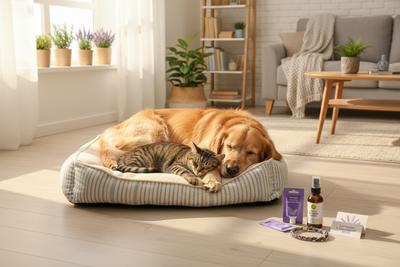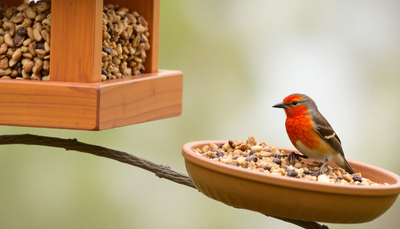Halogen heat lamps are becoming a go-to choice for reptile owners looking to create the right environment in enclosures. These lamps replicate natural sunlight, providing high-intensity light essential for Vitamin D3 synthesis, which is vital for calcium absorption. They also emit significant heat, helping reptiles regulate their body temperature effectively. With energy-efficient features and customizable wattage options, halogen bulbs can meet various reptile needs without skyrocketing electricity bills. However, remember they do not provide UVB radiation, so an additional source is necessary for species that require it. Proper positioning and maintenance will ensure these lamps last longer and support your reptiles’ health well into 2025.
Table of Contents
- Overview of Halogen Heat Lamps
- Key Features and Benefits
- High-Intensity Light Output
- Heat Emission for Reptiles
- Energy Efficiency of Halogen Bulbs
- Dimmable Options for Custom Control
- Customizable Wattages for Different Species
- Safety Considerations for Usage
- UVB Requirements for Reptiles
- Proper Positioning and Wattage
- Maintenance Tips for Longevity
- Recommendations for Reptile Keepers
- All-in-One Solutions for UVB Needs
1. Overview of Halogen Heat Lamps
Halogen heat lamps are a specific type of incandescent bulb that uses a tungsten filament to generate both light and heat. They operate at higher temperatures compared to traditional bulbs, which makes them a more efficient choice for providing light and warmth in reptile habitats. These lamps are especially beneficial for simulating natural sunlight conditions, which is essential for the health of reptiles. With their bright, white light, halogen bulbs support reptiles in their daily activities, such as basking and hunting. The compact design of halogen lamps allows for easy installation in various fixtures, making them versatile for different types of enclosures. Additionally, they are often used alongside other light sources to create a balanced environment that caters to the specific needs of various reptile species. With advancements in technology, halogen heat lamps are available in a range of designs and styles, including standard and reflector types, enhancing light distribution throughout the habitat.
2. Key Features and Benefits
Halogen heat lamps offer several key features that are beneficial for the health and well-being of reptiles. One of the standout benefits is their high light output, which closely mimics natural sunlight. This is essential for reptiles as it helps them synthesize Vitamin D3, a crucial component for calcium absorption. In addition to light, these lamps efficiently generate heat, creating basking spots that assist in thermoregulation. This is vital for reptiles, as their metabolism and digestion depend on maintaining appropriate body temperatures.
Another advantage is their longer lifespan compared to traditional bulbs. This feature reduces the frequency and costs associated with replacements, making halogen lamps a more economical choice over time. Their energy-efficient design also contributes to lower electricity bills, especially for those who use them for prolonged periods.
Moreover, many halogen lamps come with dimmable features, allowing reptile owners to adjust both the light intensity and temperature. This customization is particularly beneficial for different species, as they may have unique basking conditions. With various wattages available, these lamps can cater to specific heating needs, ensuring that even species requiring higher temperatures, like bearded dragons, can thrive.
Halogen bulbs heat up quickly, providing immediate warmth for reptiles when needed. Their compact design makes them suitable for smaller enclosures or specific areas within larger setups, offering flexibility in how they are used. Reflector types enhance light output and coverage, effectively maximizing the basking area. Additionally, installation is user-friendly and compatible with standard fixtures, making halogen heat lamps accessible for all reptile owners.
- High light output closely mimics natural sunlight, promoting health and well-being of reptiles.
- They generate heat efficiently, creating basking spots that aid in thermoregulation.
- Longer lifespan compared to traditional bulbs reduces replacement frequency and costs.
- Energy-efficient design lowers electricity costs for prolonged usage.
- Dimmable features allow for adjustable light intensity and temperature control.
- Various wattages available cater to the specific needs of different reptile species.
- Quick heating capability ensures that reptiles receive immediate warmth when needed.
- Compact design makes them suitable for smaller enclosures or specific areas within larger setups.
- Reflector types maximize light output and coverage, enhancing the basking area.
- User-friendly installation and compatibility with standard fixtures make them accessible for all reptile owners.
3. High-Intensity Light Output
Halogen bulbs are known for their bright, white light, which closely resembles natural sunlight. This high-intensity output is essential for reptiles, as it supports the synthesis of Vitamin D3, a nutrient crucial for calcium absorption. With this light, reptile owners can easily observe their pets' behaviors, making it more engaging to watch them. Additionally, the intense light helps regulate the circadian rhythms of reptiles, promoting a natural day-night cycle that is vital for their overall well-being.
One notable feature of halogen lamps is their ability to penetrate deeper into bedding materials. This ensures that the warmth reaches the reptiles effectively, creating a conducive environment for thermoregulation. The brightness of these bulbs can also discourage unwanted behaviors like hiding, as the light makes their habitat feel more inviting.
For species that thrive under direct sunlight, high-intensity output is especially crucial. Halogen bulbs can be paired with low-intensity bulbs to develop a temperature and light gradient within the enclosure, catering to the varying needs of different reptiles. Their versatility allows for use in both terrariums and larger enclosures, making them a significant advantage for reptile care.
4. Heat Emission for Reptiles
Halogen heat lamps provide a concentrated heat source that creates ideal basking spots for reptiles. This concentrated heat is essential for their ability to regulate body temperature, which is crucial for processes like metabolism and digestion. By selecting the appropriate wattage, reptile owners can customize the heat output to meet the specific needs of different species. The focused heat allows for varied temperature zones within the enclosure, promoting natural behaviors like basking. This behavior is vital for their overall health, as basking helps improve activity levels and supports digestion, especially for species requiring higher temperatures. Moreover, halogen lamps heat up quickly, offering immediate warmth during cooler periods, which can prevent stress and promote comfort in captive reptiles. These lamps can serve as a primary heat source and work well alongside other heating methods, contributing to a stable and healthy environment.
5. Energy Efficiency of Halogen Bulbs
Halogen bulbs stand out for their energy efficiency, consuming less energy than traditional incandescent bulbs. This results in noticeable cost savings on electricity bills over time. With a lifespan of up to 2,000 hours or more, these bulbs reduce the frequency of replacements, allowing reptile owners to enjoy a more economical solution for long-term use. Halogen technology also enables brighter light output with lower wattage, meaning effective heating and lighting without excessive energy consumption. This efficient use of energy translates to less heat waste and better overall performance in reptile enclosures. Many reptile keepers appreciate the consistent performance these bulbs offer throughout their lifespan, maintaining energy efficiency from start to finish. The lower operational costs compared to older bulbs make halogen lamps a popular choice, especially for those looking to support sustainable practices in reptile keeping.
6. Dimmable Options for Custom Control
Dimmable halogen lamps offer significant advantages for reptile owners looking to create tailored environments. With the ability to precisely adjust light intensity and temperature, these lamps enable owners to meet the specific needs of different reptile species. For instance, a bearded dragon may thrive under brighter conditions, while a more sensitive species might benefit from softer lighting. This flexibility allows for effective simulation of natural day and night cycles, with gradual changes in light that mimic sunrise and sunset. Such transitions can reduce stress for reptiles, promoting a healthier and more comfortable habitat.
Moreover, the dimming capability is beneficial for seasonal adjustments, allowing owners to recreate varying daylight conditions throughout the year. This adaptability encourages responsible reptile care, as it enables customized basking temperatures that align with individual species requirements. Not only does this feature enhance the well-being of reptiles, but it can also improve the visual aesthetics of the enclosure, resembling their natural habitats more closely. Ultimately, dimmable options empower owners to experiment and discover the ideal settings for their reptiles, fostering a more enriching environment.
7. Customizable Wattages for Different Species
Halogen heat lamps come in various wattages, which makes them a flexible option for reptile owners. Different reptile species have unique heating requirements, and these wattage options allow you to customize your setup accordingly. For instance, bearded dragons thrive under higher basking temperatures, so using a higher wattage bulb is essential for their health. On the other hand, smaller reptiles or those that prefer cooler environments can do well with lower wattages.
It's crucial for reptile owners to research the specific temperature needs of their pets. This ensures that the wattages selected create suitable temperature gradients within the enclosure, which is beneficial for multiple species. Using the correct wattage not only prevents overheating but also helps establish a comfortable habitat for reptiles.
Moreover, different life stages of a reptile may require varying wattages. For example, a juvenile lizard may need less heat than an adult, so adjusting the wattage as they grow can provide tailored care. The flexibility in wattage also accommodates various enclosure sizes, making it easier to create a conducive environment.
Additionally, the ability to adjust wattages based on seasonal changes or behavioral observations allows for a more responsive care approach. If you notice your reptile seeking warmth more often during colder months, you can increase the wattage accordingly. This adaptability enhances the overall effectiveness of your lighting and heating solution, ensuring that your reptile remains healthy and comfortable.
8. Safety Considerations for Usage
When using halogen heat lamps for reptiles, safety is a top priority. These bulbs can reach very high temperatures, so proper placement is essential to prevent burns to both your reptiles and yourself. Make sure to secure the bulbs in fixtures that prevent them from falling or coming into contact with any flammable materials. Regular inspections of both the wiring and the fixtures are necessary to ensure everything is in good condition and free from damage.
To protect your reptiles, consider using guards or screens that shield them from direct contact with the hot bulbs. It's also important to keep the bulbs away from bedding materials that could ignite under high heat. Regularly monitor the enclosure's temperature to avoid overheating, which can harm your reptiles. Using thermostats or timers can help automate temperature control, maintaining a safe environment.
Educate yourself about the appropriate wattage and placement for the specific species you are keeping. Not all reptiles have the same heating needs, so understanding these requirements is crucial. Ensure the bulbs are compatible with the fixtures to avoid any electrical hazards. When it's time to replace a bulb, allow it to cool completely before handling to avoid burns. Keeping these safety considerations in mind will help create a secure and healthy habitat for your reptiles.
9. UVB Requirements for Reptiles
Halogen bulbs are great for providing heat and light, but they do not emit UVB radiation, which is crucial for many reptiles. If your reptile needs UVB exposure, you will need to install a separate UVB light source. It's important to position the UVB light in a way that complements the halogen bulb's heating capabilities. Different species have varying UVB requirements, so research which type and strength of UVB lamp is best suited for your reptile.
Regular maintenance is key; UVB bulbs lose their effectiveness over time, so plan to replace them every 6 to 12 months. Additionally, monitor the distance between the UVB source and the basking area to ensure your reptile receives adequate exposure. Using a UVB meter can help you gauge the effectiveness of the lighting in the enclosure. Some reptiles may need more intense UVB exposure during specific life stages, so be prepared to adjust your setup as necessary. Educating yourself about the UVB needs of your reptiles will enable you to provide the best care possible. Combining halogen lamps with UVB sources creates a balanced environment, ensuring your reptiles stay healthy and active.
10. Proper Positioning and Wattage
The correct positioning of halogen bulbs is vital for effective heating and lighting in reptile enclosures. Mounting the bulbs at an appropriate height allows for a cozy basking area while minimizing the risk of overheating. Wattage selection should align with the size of the enclosure and the specific needs of the reptile species. For example, larger species might require higher wattage to achieve necessary basking temperatures. To ensure accuracy, using a thermometer to monitor temperatures in various areas of the enclosure is essential. Adjusting the distance between the bulb and the basking spot can help achieve the desired temperatures for your reptiles.
Furthermore, consider the layout of the enclosure to create distinct temperature zones, allowing reptiles to choose their preferred basking or cooler spots. It's crucial to avoid placing bulbs too close to water sources to prevent electrical hazards. Regularly checking and adjusting the setup based on your reptiles' behaviors and health is equally important. Always be aware of your fixtures' maximum wattage capacity to ensure safety and efficiency. Ultimately, proper wattage and positioning can greatly enhance the comfort and health of reptiles in captivity.
11. Maintenance Tips for Longevity
To ensure your halogen heat lamps last as long as possible, regular maintenance is crucial. Start by cleaning the bulb frequently to remove dust and dirt, which can obstruct light and heat output. It's also important to inspect the bulb for any signs of wear or damage; if you notice any issues, replace it promptly to maintain safe operation. Avoid touching the glass part of the bulb with bare hands, as the oils from your skin can reduce its lifespan.
Using a timer can help manage the on and off cycles of the lamp, which promotes consistent heating without overworking the bulb. Position the lamp at an appropriate distance from your reptiles to prevent overheating and potential burns. Regularly check the enclosure temperature with a reliable thermometer, and adjust the bulb's position if necessary to achieve the desired heat levels.
Follow the manufacturer's recommended schedule for bulb replacement, even if the bulb appears to be functioning well. Ensure that any fixtures you use are rated for the wattage of your halogen bulb to prevent electrical hazards. Store any spare bulbs in a cool, dry place to protect them from moisture damage before use. Additionally, consider using a wattage meter to monitor energy consumption, helping you maintain a cost-effective setup.
12. Recommendations for Reptile Keepers
When selecting halogen heat lamps for your reptiles, it is essential to consider the specific needs of your pets. For reptiles that require a basking spot with intense heat and light, halogen bulbs are an excellent choice. If your reptiles also need UVB exposure, pairing halogen lamps with a quality UVB fixture will provide optimal health benefits. Researching the temperature needs of your specific reptile species is crucial, as it will help you select the appropriate wattage and positioning of the bulb to meet their requirements. Regularly monitoring the enclosure environment ensures it meets their needs, allowing you to make adjustments to the lighting as necessary.
Combining halogen lamps with other heating methods, such as heat mats or ceramic heat emitters, can create a balanced heating environment. Dimmable halogen options are also worth considering for reptiles that require varying basking conditions throughout the day. Investing in bulbs with a longer lifespan can reduce maintenance and replacement costs, making them a practical choice.
Before making a purchase, look for customer reviews and seek expert advice regarding the performance of specific bulbs for your reptile species. Choosing quality fixtures designed for halogen bulbs is important, as they provide better safety and efficiency. Finally, staying updated on new products and technologies in reptile lighting can enhance your enclosure setup, ensuring a healthy and comfortable habitat for your reptiles.
13. All-in-One Solutions for UVB Needs
If you're looking for a straightforward way to meet both the heat and UVB needs of your reptiles, consider using mercury vapor bulbs. These all-in-one solutions can simplify your setup, especially in larger enclosures where managing multiple light sources can be cumbersome. Different species of reptiles have varying UVB requirements, so it's essential to evaluate the specific needs of your pets before making a choice.
Make sure to research the effectiveness of different brands of all-in-one bulbs, as not all products are created equal. Over time, the UVB output of these bulbs can degrade, so monitoring their performance is crucial to ensuring your reptiles receive adequate exposure. Be mindful that wattages can vary based on the size of the enclosure, and placing the basking area beneath the bulb is key for maximum benefit.
When planning your maintenance schedule, consider the lifespan of these bulbs. Additionally, check for compatibility with your existing fixtures to avoid any installation issues. Using a UV meter can help you confirm that your reptiles are getting the right amount of UVB exposure, which is vital for their health.
Frequently Asked Questions
Why should I use halogen heat lamps for my reptiles?
Halogen heat lamps provide consistent heat and help maintain the right temperature for reptiles, which is crucial for their health and digestion.
How do halogen heat lamps compare to other heating options for reptiles?
Halogen heat lamps are more energy-efficient and produce focused heat compared to other options, like incandescent bulbs, which can be less effective.
What wattage should I choose for my halogen heat lamp?
The wattage depends on the size of the enclosure and the specific needs of your reptile, so it is best to consult care guides or an expert for recommendations.
Can halogen heat lamps be used with a thermostat?
Yes, using a thermostat is a good idea as it helps regulate the temperature more accurately, ensuring your reptile stays comfortable.
Are there any safety concerns with halogen heat lamps?
Halogen lamps can get very hot, so always ensure they are securely mounted and not placed too close to the animals or materials that could catch fire.
TL;DR Halogen heat lamps are popular for reptiles in 2025 due to their high-intensity light output, effective heat emission, and energy efficiency. They come in customizable wattages and dimmable options for precise control, making them suitable for various species. However, they do not emit UVB light, so additional UVB sources are necessary. Proper positioning and maintenance are crucial for safety and longevity. Halogen lamps are ideal for reptile keepers who have separate UVB fixtures, while mercury vapor bulbs may be better for those needing both heat and UVB.






